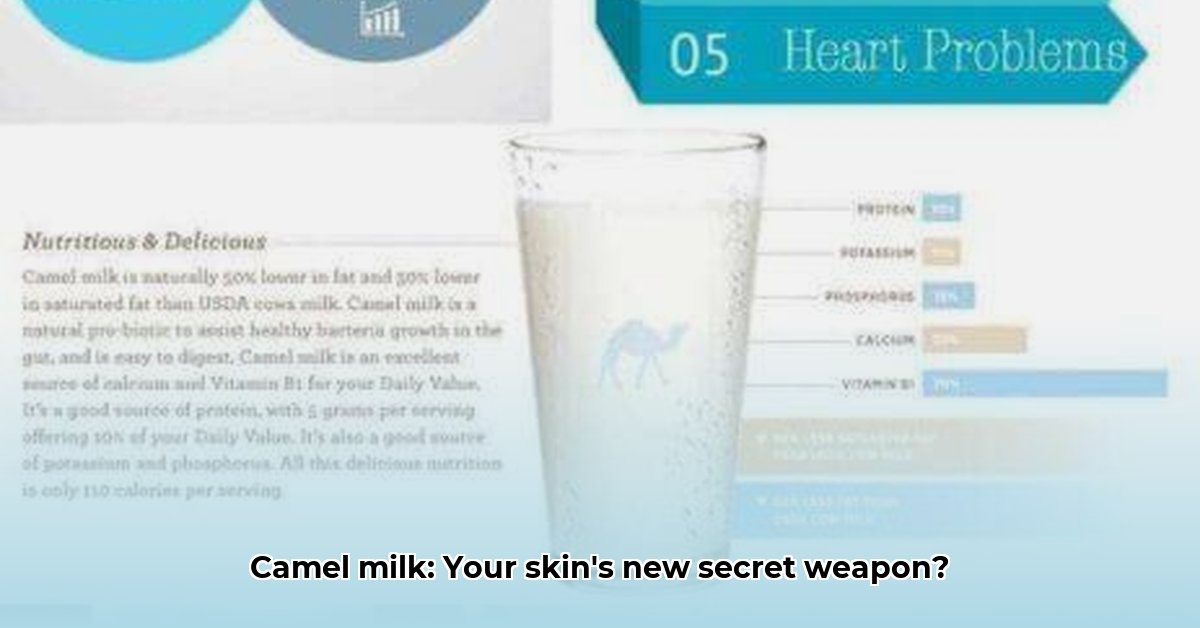
Camel milk has emerged as a trending skincare ingredient, promising a range of benefits from improved hydration to soothing inflammation. But does the science support the hype? This comprehensive review examines the current research, separating established facts from areas needing further investigation, providing you with the knowledge to make informed decisions about incorporating camel milk into your skincare routine.
Understanding Camel Milk's Composition and Potential Benefits
Camel milk's allure stems from its unique nutrient profile. It's rich in vitamins (A, C, and E), minerals (zinc and calcium), and alpha-hydroxy acids (AHAs – natural exfoliants). These components contribute to its purported moisturizing, anti-inflammatory, and antimicrobial properties. Lactoferrin, an iron-binding protein, and immunoglobulins, antibodies that contribute to the immune system, also add to its potential benefits. Is this ancient remedy truly a modern skincare miracle? Let's delve deeper.
The Current State of Scientific Evidence: A Critical Review
While camel milk's nutrient-rich composition suggests potential skincare benefits, robust clinical trials confirming these benefits are currently lacking. Existing studies, often small and lacking in rigorous methodology, hint at potential improvements in skin hydration and symptom relief for conditions such as eczema and psoriasis. However, these findings are preliminary and require validation through larger, more controlled studies. There's a consensus on its moisturizing properties, thanks to its fatty acid profile similar to lanolin, but claims of anti-aging effects or acne treatment require more conclusive evidence. What does this mean for consumers? Proceed with caution, understanding that more research is needed to fully understand its efficacy.
What the Research Shows (and Doesn't): A Balanced Perspective
The existing research presents a mixed picture. While the moisturizing properties of camel milk seem established, thanks to its fat content and lanolin-like substances, evidence supporting further benefits is less robust. Studies showing improvements in conditions like eczema are promising, but often limited in scope. This lack of comprehensive data underscores the crucial need for larger-scale, well-designed clinical trials to determine camel milk's true efficacy and safety across different skin types and conditions.
Choosing Camel Milk Skincare Products: A Practical Guide
Intrigued by camel milk's potential? It's important to choose products wisely and use them cautiously, especially if you have sensitive skin.
- Patch Test: Before widespread application, perform a patch test on a small, inconspicuous area of skin to check for allergic reactions. Wait 24-48 hours to monitor for redness, itching, or irritation.
- Ingredient Transparency: Choose products from reputable brands that clearly list all ingredients and provide information on sourcing and production methods.
- Start Gradually: Begin with infrequent applications and gradually increase frequency as tolerated.
- Monitor Skin's Response: Pay close attention to your skin's reaction. Discontinue use if any irritation occurs.
- Look for Certifications: Products with independent certifications for quality and safety are preferable.
Addressing Concerns: Potential Risks and Ethical Considerations
While the potential benefits are noteworthy, several concerns warrant discussion. Allergic reactions, although uncommon, are possible, particularly for individuals with dairy sensitivities. Additionally, the sustainability of large-scale camel milk production for cosmetics remains a concern. Ethical and sustainable sourcing should be a priority when selecting products. The variability in camel milk composition based on camel diet and breed can also affect product efficacy. What are you willing to compromise on?
The Future of Camel Milk in Skincare: Outlook and Research Needs
The future of camel milk in skincare hinges on further research. Larger-scale clinical trials, conducted with rigorous methodology and diverse participant groups, are essential to confirm its purported benefits and establish clear safety guidelines. Collaboration between researchers, dermatologists, and skincare companies is crucial to unlock camel milk's full potential responsibly and ethically.
Conclusion: Informed Decisions Based on Available Evidence
Camel milk’s potential skincare benefits warrant further investigation. While its moisturizing properties seem promising, the lack of substantial evidence regarding other claims necessitates a cautious approach. Consumers should exercise informed judgment when choosing products, prioritizing quality, transparency, patch testing, and awareness of the ongoing research. The future holds exciting possibilities, but only rigorous scientific investigation will determine camel milk's true place in the skincare landscape. Do you find the current evidence compelling enough to try it?